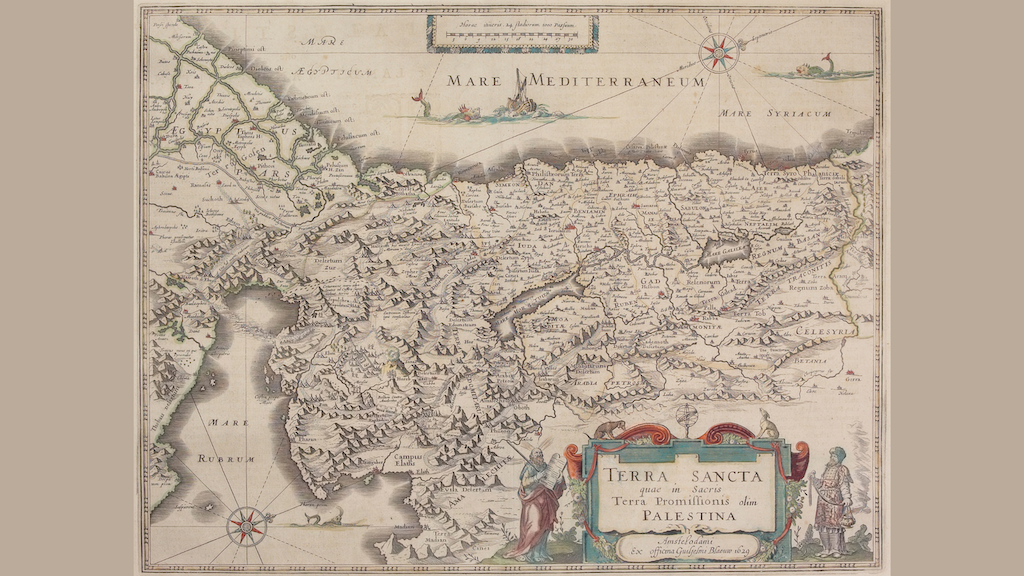A Short History of Palestine
The name “Palestine” was first used in 135CE by the Roman Emperor Hadrian when he overcame the Bar Kokhba uprising. “Palaestina” is derived from a Latinised corruption of the Greek name “Philistia”—the land of the Philistines (invaders). Hadrian used the name in order to sever all Jewish connection to thegeographical area covering current Israel, Gaza, West Bank and western part of Jordan.[1]
Abraham, commonly considered today as the patriarch of the three monotheistic religions (Judaism, Christianity and Islam) first came to the region from Babylonia in about 2100BCE. Around 1500BCE the Jewish people – Abraham’s descendants through the line of Jacob – came back, having been exiled in Egypt for 400 years. In about 1000BCE the Kingdom of Israel under King David was established, and its centre established in Jerusalem. The kingdom split into the kingdoms of Israel and Judea. The Romans took control of this region, which they called Judaea, in 63BCE.
In 66CE, the Jewish people rose up against the Romans. In 70CE Titus, the son of the Roman Emperor Vespasian, and his army sieged Jerusalem and destroyed the Second Temple, killing more than one million Jews.[2] Most of the survivors fled the country and were dispersed throughout the Roman Empire and beyond.[3] A small Jewish community remained in the land of Israel. A second uprising under Bar Kokhba (Bar Kosiba) was defeated in 135 CE and Judea was renamed Syria Palaestina by Roman Emperor Hadrian.
A small number of Jews remained in the land, but most surviving Jews were scattered throughout the Middle East and beyond. Many found refuge in Arabia, where they established settlements and spread Aramaic and Hellenistic culture.
Strategically situated at the meeting point of Europe, Asia and Africa,[4] “Syria Palaestina” was the crossroads of many different cultures, religions, ethnic groups, and economic interests. Different people groups moved in and out of the region – including Jews, Christians and Muslims (of many different nationalities), Arabs, Bedouins, and Turks.
The region came under successive foreign rulers: Romans (135 to 324), Byzantines (324 to 638), Arabs (638 to 1099), Crusaders (1099 to 1291), Mamelukes (1265 to 1516), and Ottomans (Turks) (1516 to 1917). Each successive conqueror allowed or promoted immigration from a variety of countries and nationalities.[5]
During the seventh century, Muslims decimated many of the Jewish and Christian populations in Arabia. Sweeping northward from the Arabian Peninsula through the Middle East and into southern Europe and central Asia, Arab Muslims conquered Jerusalem in 637 CE. At this time several hundred thousand Jews were living in Palestine.[6] In the subsequent centuries, although the composition, size and location of the Jewish population in Palestine varied considerably, they remained one of the main population groups in Palestine.[7]
From 1514 to 1918, the Ottomans governed their empire through a system of administrative/geographic divisions. In 1864, the Sublime Porte promulgated an edict establishing the Vilayet system, in which the Empire was divided into Vilayets (Provinces) comprised of subdivisions known as Sanjaks. Several Sanjaks, including the Sanjak of Jerusalem, were “independent,” meaning they were not part of a larger Vilayet and instead reported directly to Constantinople for strategic reasons or, in the case of Jerusalem, for religious and political reasons. By 1905 the Empire outside Constantinople contained 29 Vilayets containing a total of 120 subordinate Sanjaks, plus six independent Sanjaks. The independent Sanjak of Jerusalem comprised portions of ancient Judea and the northern Negev Desert. Palestine itself, however, was not a Vilayet and had no recognized political or geographic status in the Ottoman empire. The remainder of Palestine outside the independent Sanjak of Jerusalem was subsumed within the Vilayet of Beirut.[8]
Strategically located at the gateway to the East, and hosting many Jewish, Christian and Muslim holy places in and near to Jerusalem, this region was of enormous strategic and religious significance for the various European powers and thus both the cause and locus of tension and conflict during the 19th century, into the first decades of the 20th century.
During the 19th century, Jews started to return to Palestine in larger numbers, mainly escaping rising antisemitism in eastern Europe. The Zionist movement took on serious political form when the first Zionist Congress was held in Basel in 1897, under the inspired leadership of Theodor Herzl.
By the mid-19th century, the population in the land between the Mediterranean Sea and the Jordan River had become a heterogeneous mix of many different nationalities, ethnic groups, and religions. In 1881 there were about 450,000 non-Jews (90 percent Muslim, 10 percent Christian) and 27,000 Jews in Palestine.[9] The “Second Aliyah” wave (1904-1914) saw many Jews enter Palestine, fleeing from the pogroms in Russia.
By 1914, there were approximately 90,000 Jews and 500,000 “Arabs” in Palestine.[10] The Arab population actually comprised a rich diversity of national, ethnic and religious groups, including Arabs, Armenians, Turks, Circassians, Algerians, Egyptians, Druze, Kurds and Bosnians, most of whom had come from other places over the course of the preceding centuries.[11]
For Jews in the diaspora, Jerusalem remained the centre of their spiritual and national life. One of the four main centres of Judaism in Palestine was Jerusalem. Ever since the destruction of the Second Temple in 70 CE, there has always been a Jewish community in the Old City of Jerusalem (with the exception of the period 1949-1967). In 1881, Jews constituted 52 percent of the population of Jerusalem. By 1914, Jews constituted 42 percent of the population of Jerusalem, which by then had extended beyond the Old City walls.
In 1917, the British published the “Balfour Declaration”, declaring their support for the establishment of a homeland for the Jewish people in Palestine. This declaration was ratified by the Allies in 1920, and adopted by the League of Nations and included in 1923 in the Mandate for Palestine, which stated that “recognition has thereby been given to the historical connection of the Jewish people with Palestine and to the grounds for reconstituting their national home in that country.” The intention of the Mandate was that a Jewish homeland would be established in Palestine, while all the time ensuring that “nothing should be done which might prejudice the civil and religious rights of existing non-Jewish communities in Palestine, or the rights and political status enjoyed by Jews in any other country.”
The Mandate for Palestine laid the foundations for the establishment of the State of Israel in May 1948: a democratic State which has a Jewish identity, but in which Jews and non-Jews have equal civil, political and religious rights.
Footnotes
[1]Gilbert (1978), p. 6; Keller (1966), p. 91.
[2] Josephus (1987), Chapter 9.3, p. 749.
[4] See for a general overview Gilbert (1978); Peters (1984), pp. 145-95; Lewis (1995).
[5] Peters (1984), pp. 151-57.
[7] See Karsh (2010), p. 9, citing Gil (1992).
[8] Zipperstein, Steven E. Law and the Arab-Israeli Conflict: the Trials of Palestine (Routledge, 2020) p.39.
Further reading
Even, A., 1968. My people. The Story of the Jews. New York: Behrman/Random House.
Gil, M., 1992. A History of Palestine, 624-1099. Cambridge: Cambridge University Press.
Gilbert, M., 1978. Exile and Return. The Emergence of Jewish Statehood. London: Weidenfels and Nicolso.
Josephus, F., 1987. The Wars of the Jews. Translated by William Whiston. Peabody, Mass.: Hendrickson Publishers.
Karsh, E., 2010. Palestine Betrayed. New Haven: Yale University Press.
Keller, W., 1966. Und wurden zerstreut unter alle Völker. Knaur: München Zürich.
Lewis, B., 1995. The Middle East: 2000 Years of History from the Rise of Christianity to the Present day. London: Weidenfeld and Nicolson.
Morris, B., 2008. 1948: A History of the First Arab-Israeli War. New Haven/London: Yale University Press.
Peters, J., 1984. From Time Immemorial. The Origins of the Arab-Jewish Conflict over Palestine. New York: Harper & Row.
Zipperstein, Steven E. Law and the Arab-Israeli Conflict: the Trials of Palestine (Routledge, 2020)





